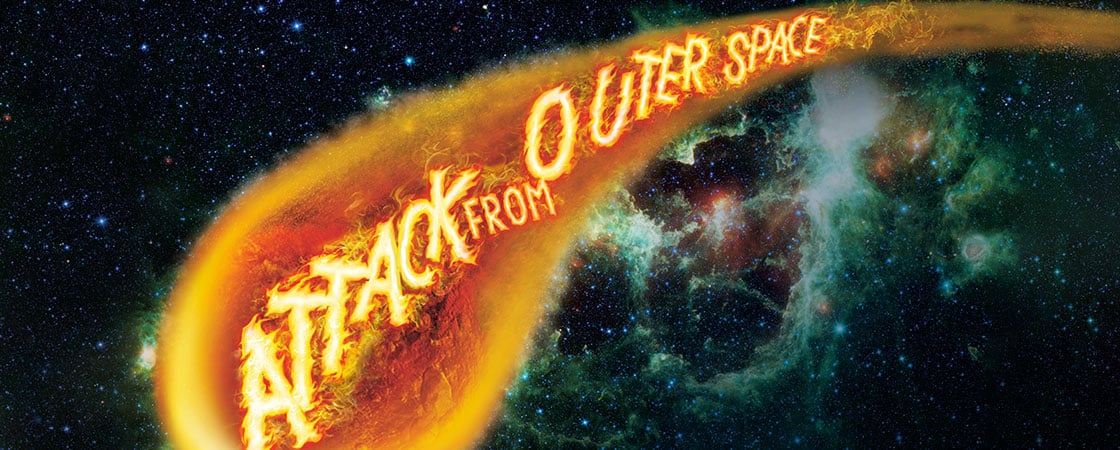February 15, 2013, starts as a normal day in Chelyabinsk [CHEL-yah-binsk], Russia. People eat breakfast, drive to work, and head to school. But for the 1.1 million people who live in this busy city, everything is about to change.
A space rock is headed for Chelyabinsk. It’s 55 feet across! And nobody knows it’s coming.
This rock has been circling close to Earth for thousands of years. Finally, this morning, it enters our atmosphere, the layer of gases surrounding our planet.
Zooming toward Earth’s surface, the rock gets hotter and hotter. The heat is so strong that the rock starts to crumble. It’s traveling 40,000 miles an hour. (Picture a rocket shooting into the sky. The rock was moving more than twice as fast!) Now it’s close to the ground, and it won’t be long until . . . it explodes!
The residents of Chelyabinsk stare as a fireball streaks across the blue-pink morning sky. It disappears in a flash of light brighter than the sun. A trail of smoke is left behind. Some people run outside or go to their windows for a better look. Others pull their cars over.
What was that? A missile? A plane crash? Aliens?!
Two looong minutes pass. And then—
BOOM! SMASH!
Walls collapse. People are knocked to the ground. Windows shatter. Razor-sharp pieces of glass fly into homes, schools, and offices. In an instant, 1,500 people are injured.
They are lucky. It could have been worse.
February 15, 2013, started as a normal day in Chelyabinsk [CHEL-yah-binsk]. This is a city in Russia. People ate breakfast, drove to work, and went to school. On that morning, a space rock flew into the atmosphere. That’s the layer of gases around Earth. The rock had been flying around Earth for thousands of years.
The rock zoomed toward Russia. It left behind a line of smoke. The rock got hotter and hotter. Then it seemed to disappear. People in the city waited to see what happened next. Two long minutes passed. And then—
BOOM! SMASH!
A thousand people got hurt by the explosion. But they were lucky. It could have been worse. No one was killed.
February 15, 2013, starts as a normal day in Chelyabinsk [CHEL-yah-binsk], Russia. People eat breakfast, drive to work, and go to school. About 1 million people live in this city. But everything is about to change.
A space rock is about to hit Chelyabinsk. It’s 55 feet across! And nobody knows it’s coming.
This rock has been flying around Earth for thousands of years. This morning, it enters the atmosphere. That’s the layer of gases around Earth.
The rock zooms toward Earth’s surface. It gets hotter and hotter. The heat is so strong that the rock starts to break. It’s traveling 40,000 miles an hour. Now it’s close to the ground, and soon . . . it explodes!
The people in Chelyabinsk stare as a fireball flies across the blue-pink sky. It disappears in a flash of bright light. A line of smoke is left behind. Some people run outside or go to their windows to look. Others pull their cars over.
What was that? A missile? A plane crash? Aliens?!
Two looong minutes pass. And then—
BOOM! SMASH!
Walls break. People fall to the ground. Windows explode. Pointy pieces of glass fly into homes, schools, and offices. About 1,500 people are hurt in an instant.
They are lucky. It could have been worse.
As the sun rises on February 15, 2013, the people of Chelyabinsk, Russia, start their mornings as usual, eating breakfast, driving to work, and heading to school. But the 1.1 million residents of this busy city are in for a very unusual day. This morning, a space rock 55 feet across—about as wide as your school gym—is headed directly for Chelyabinsk. And nobody has any idea.
This rock has been circling close to Earth for thousands of years. Finally, this morning, it enters our atmosphere—the layer of gases that surrounds our planet.
Zooming toward Earth’s surface, the rock gets hotter and hotter. The heat is so intense that the rock starts to crumble as it travels 40,000 miles an hour—more than twice as fast as most rockets at liftoff. Now it’s about 15 miles above the ground, and it won’t be long until . . . it explodes!
The residents of Chelyabinsk gawk, puzzled, as a brilliant fireball streaks across the blue-pink morning sky and disappears in a blinding flash of light brighter than the sun. An eerie trail of smoke is left behind. Some people run outside or go to the windows for a better look. Others pull their cars over, alarmed.
What was that? A missile? A plane crash? Aliens?!
Two uneasy minutes pass. And then—
BOOM! SMASH!
Thunderous bangs echo as invisible shock waves shake Chelyabinsk. Walls collapse. People are knocked to the ground. Windows shatter, flinging razor-sharp shards of glass into homes, schools, and offices throughout the city. In a single instant, about 1,500 people are injured.
They are lucky. It could have been worse.

